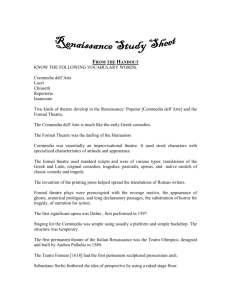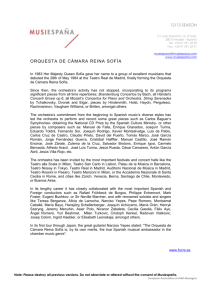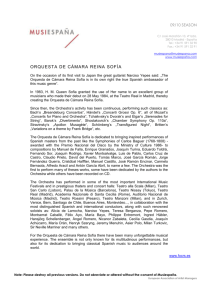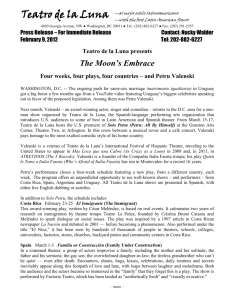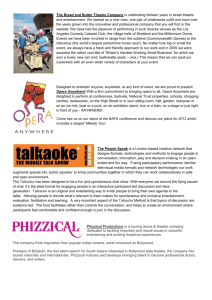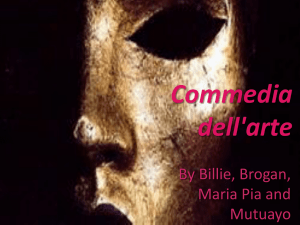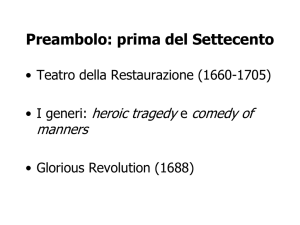Theatre 100: Intro to Theatre
advertisement
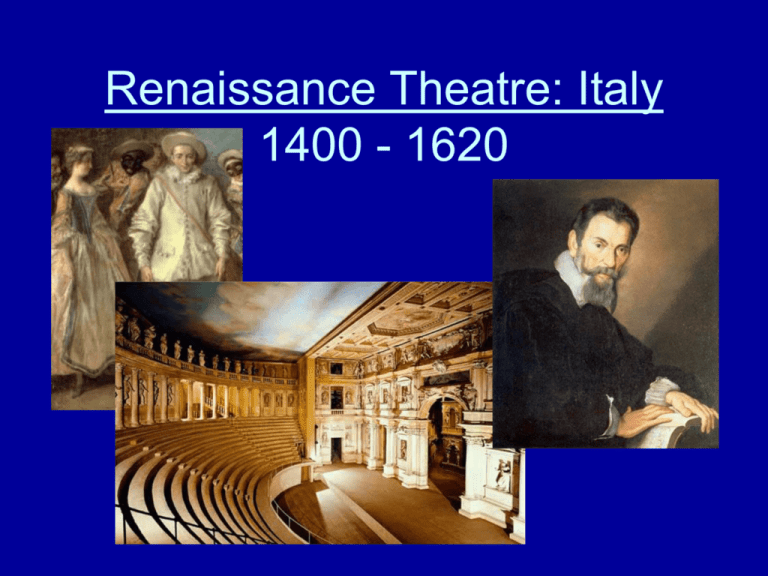
Renaissance Theatre: Italy 1400 - 1620 Contributions of the Italian Renaissance 1. 2. 3. 4. Commedia dell'arte Opera Proscenium Theatre Painted Scenery Commedia dell'arte Commedia dell'arte • The popular theatre of Renaissance Italy • Much of the dialogue and business was improvised • A scenario was posted back stage • Produced mostly low comedy, slap stick • Used stock characters similar to Plautus Stock Characters of the Commedia The straights – A pair of young lovers.. 1. A dapper young man 2. A sophisticated young lady, noble and innocent. Stock Characters of the Commedia • Il Capitano – a pompous braggart who boasted of his great prowess in love and battle, but was usually discredited in both Stock Characters of the Commedia • Pantalone -- a greedy, lustful, meddling old man. Often a merchant Stock Characters of the Commedia • Il Dottore – A doctor (or professor) who spoke inaccurate Latin. His standard dress was the academic cap and gown. Stock Characters of the Commedia • Two servants or zanni. One smart and one less smart. The less smart servant was usually an insolent liar, thief and/or drunkard. • Most of the humor came through the actions of the servants. Commedia's Influence • Characters and bits of comic business were borrowed by Shakespeare for Taming of the Shrew and All's Well That Ends Well and… Commedia's Influence • Moliere’s The Doctor in Spite of Himself is borrowed from a Commedia scenario Birthplace of Opera Firenze (Florence) Location of Firenze The Birth of Opera • First opera: Dafne • Based on a Greek legend • Produced by the Camerata, an Italian academy in 1597 • By Ottavio Rinuccini (text) and Jacopo Peri (music) • They were attempting to recreate an "authentic Greek tragedy." Camerata Fiorentina • An association (or "academy") of wealthy Italians who met at home of Count Giovanni de’ Bardi to study the arts (including music and drama) of ancient Greece and Rome • They believed the arts had become corrupted and could be improved by returning to the original style • They believed that Greek drama was primarily sung, not spoken Dafne • The story of Apollo (God of light) falling in love with Daphne, a nymph. • Prologue + 6 scene • Presented to members of the Camerata • Mostly semi-song dialogue • Text, but not music, published in 1600 • Composed and published in 1601 • By the team that created Dafne • For the court wedding of King Henry of Navarre and Marie de Medici • Performed at the Medici's Palazzo for a court audience Euridice Opera’s First Major Composer Claudio Monteverdi, Court composer of Mantua 1567-1643 His First Major Work L’Orfeo performed in Madrid Monteverdi’s Formula Monteverdi increased the size of the orchestra, shifting the emphasis from the text to the music 1. Aria: A solo sung by one of the opera's major character 2. Recitative: The chanted dialogue which joins the opera's musical moments. Giuseppe Verdi 1813-1901 • Most often produced composer at the Metropolitan Opera • Wrote mostly tragic operas • One comic opera: Falstaff • Most famous work: Aida Aida by Verdi Richard Wagner 1813 - 1883 • German opera composer • Believed that opera should be a "total art work." • created music dramas based on Teutonic myths and legends Wagner's Music Drama • No distinction between a recitative and an aria • One long continuous melody line • Melody created by combining themes (leitmotifs) which represent characters, objects, and emotions Wagner's masterpiece Der Ring des Nibelungen 1. 2. 3. 4. Das Rheingold ("Rhinegold") Die Walkure ("The Valkyries") Siegfried Gotterdammerung ("The Twilight of the Gods") Combined playing time of seventeen hours Die Walkure Evolution of the Proscenium Theatre Marcus Vitruvius Pollio 90-20 BCE • Roman writer, architect and engineer • Served both Julius Caesar and Caesar Augustus • Wrote de Architectura libri decem ("The Ten Books on Architecture“) • Described both Greek and Roman theatres • Had a monumental effect on Renaissance architecture de Architectura libri decem Teatro Olimpico 1580 – 1584, Vicenza Location of Vicenza Teatro Olimpico • Oldest surviving Renaissance playhouse • Combination of the old - a classical Roman facade and the new -- a perspective vista • Attempting to create for the Accademia Olimpica an, accurate indoor Roman theatre • Designed by Andrea Palladio (1508-1580) and Vincenzo Scamozzi (1552-1616) Teatro Olimpico Front Entrance Teatro Olimpico In Performance Today Teatro Olimpico Floor Plan Stage Teatro Olimpico Cross Section Thru Center Line Teatro di Sabbioneta 1588-1590, Sabbioneta Location of Sabbioneta Teatro di Sabbioneta • Designed by Vincenzo Scamozzi • Small, intimate, 250 seat playhouse • Contained only 5 rows in the cavea and a single street scene • First European indoor theatre built as a theatre Teatro Sabbioneta Scamozzi’s Plan and Cross Section Teatro Sabbioneta Cavea (seating) Teatro Sabbioneta Stage Teatro Farnese 1618, Parma Teatro Farnese Palazzo della Pilotta Teatro Farnese • First permanent proscenium theatre • Built into the Great Hall of the Palazzo della Pilotta • Used primarily for state functions • Almost destroyed by Allied bombs during World War II • Rebuilt in the 1950s Location of Parma Teatro Farnese View of the Stage Teatro Farnese View from the Stage Teatro Farnese Plan View Stage Proscenium Arch Teatro Farnese Cross Section Thru Center Line Painted Scenery In The Beginning… • Around 1415: Filippo Brunelleschi discovers the secret of linear perspective: a mathematical system for creating the illusion of space and distance on a flat surface • 1435: Leon Battista Alberti publishes Brunelleschi's secret in Della Pitture • 1508: Pellegrino di San Daniele places individual houses in front of a painted backdrop for a staging of Ariosto's The Casket at Ferrara Sebastiano Serlio 1475-1554 An Italian writer and court architect publishes Regole generali di architettura (1545) the first work detailing the design and construction of a court theatre 1. Describes the set for a tragedy, comedy and pastoral play 2. Gives instructions on how to lay out a theatre in a “Great Hall” 3. Create perspective scenes From Vitruvius… • There are three sorts of scenes, the Tragic, the Comic, and the Satyric. The decorations of these are different from each other. • The Tragic scenes are ornamented with columns, pediments, statues, and of the royal decorations. • The Comic scene represents private buildings and galleries, with windows similar to those in ordinary dwellings. • The Satyric scene is ornamented with trees, caves, hills, and of the rural objects in imitation of nature. Serlio: Layout of a Theatre Serlio: Tragedy Set Serlio: Comedy Set Serlio: Pastoral Set Ideal City (1470) Piero della Francesca Wing – Border -- Backdrop Wing Border Back Drop • Wing: A piece of scenery on the side of the stage used to mask the side walls of the theatre. • Border: A piece of scenery hung above the stage used to hide the rafters, pulleys, and ropes used to change the scenery. • Backdrop: A large piece of scenery at the rear of the stage used to mask the back wall. Wing-Border-Backdrop Set Annie Get Your Gun Wing Unit Hotel Tree Portal Back Drop Woods with Clearing Perspective Study Raffaello Sanzio (1483 -1520) Perspective Study Jean Cousin (1500-1560) One Point Perspective Giacomo Torelli (1608-1678) An Exterior Set Giacomo Torelli (1608-1678) Two Point Perspective Filippo Juvarra (1678-1736) Two Point Perspective Giovanni Piranesi, (1720-1778)
